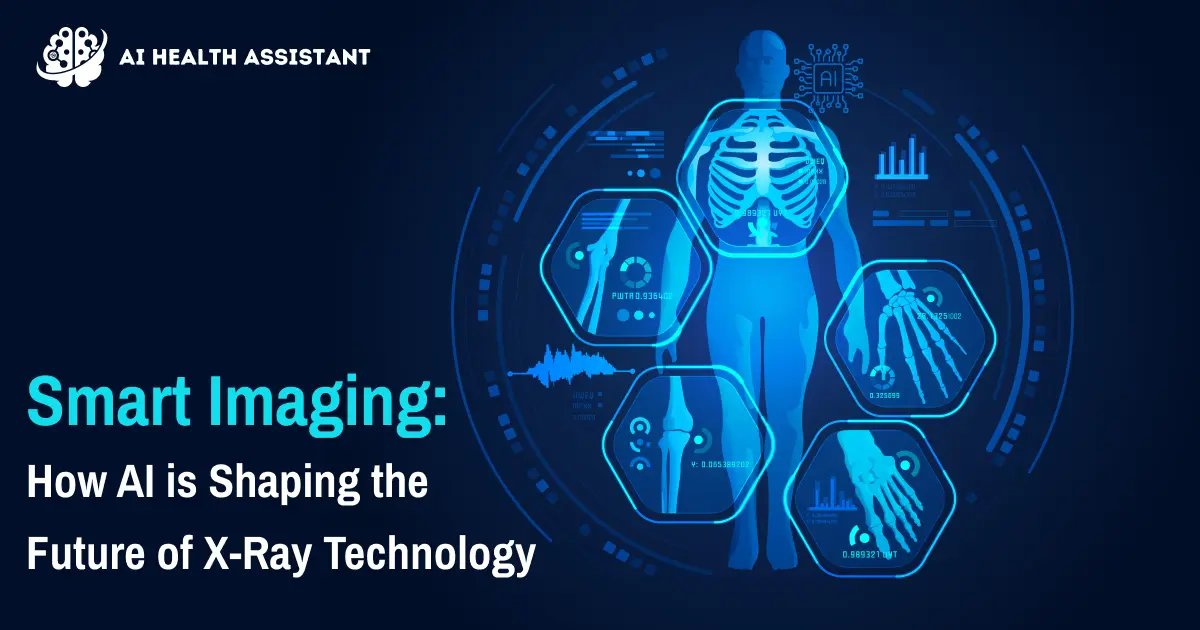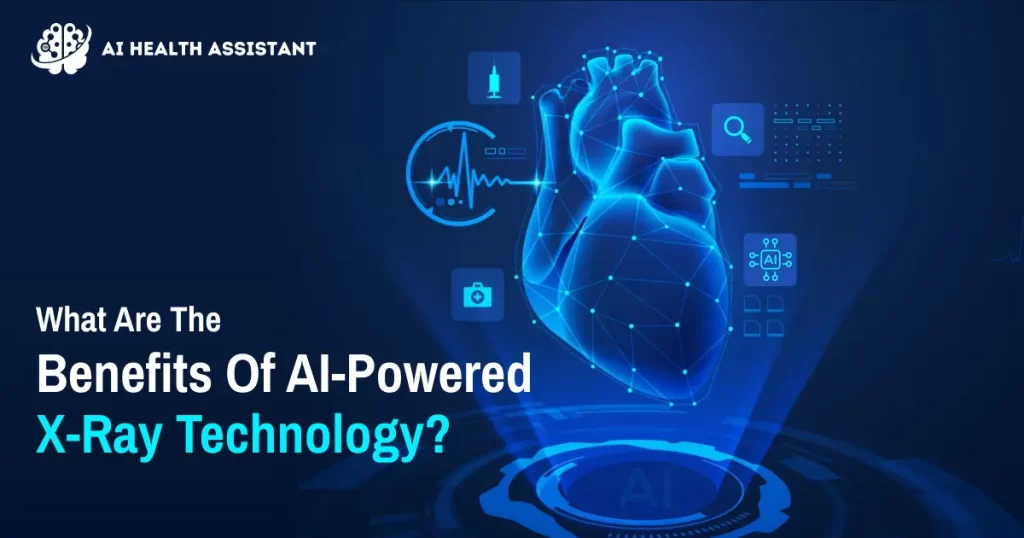
Smart Imaging: How AI is Shaping the Future of X-Ray Technology
The healthcare industry is making significant progress through the swift advancement and widespread implementation of artificial intelligence (AI) in various domains. Integrating clinical data and AI in healthcare applications not only automates jobs and saves time, but also offers significant benefits in fields like radiology. These applications can improve processes and assist physicians in effectively managing the extensive data generated by imaging exams.
Artificial intelligence can detect and analyze patterns in image data. This program aims to assist clinicians by automating workflows and identifying critical findings, thereby reducing their workload. AI solutions for X-rays are integrated into imaging systems to identify complex image patterns and promptly prioritize important cases for radiologist review.
In this blog post, we will investigate AI’s profound effect on X-ray technology. So let’s get going immediately.
How is AI Transforming X-ray Technology?
AI is revolutionizing X-rays by addressing the inherent problems of traditional methods. Due to its enhanced image processing, streamlined workflow, and improved diagnostic accuracy, AI is a significant advance in medical imaging.
Enhanced Image Analysis & Interpretation
AI Algorithms for Image Processing
- High-tech solutions: AI algorithms use advanced image-processing techniques, such as noise reduction or contrast enhancement and even the ability to reconstruct 3D images from 2D X-ray scans. These methods improve the clarity of images, making it easy to identify critical features.
- Reduction of Noise: AI reduces the grainy look (noise), resulting in more detailed and smoother visuals.
- Improvement of Contrast: A better contrast provides a clearer view, as it allows for better differentiation between tissues and other structures.
- Resolution Boost: AI enhances the resolution in images to enable the detection of more intricate structures.
- Automatic Adjustments: AI automatically adjusts image parameters according to the needs of each individual case, ensuring optimal visualization.
Automated Detection and Abnormalities
- Pattern Recognition: AI systems recognise patterns and anomalies that humans often miss. AI’s ability to detect abnormalities improves as it learns continuously from vast datasets.
- Fractures & Lesions: AI can automatically identify lesions, fractures, and other abnormalities. Early warnings can be critical to patient care.
- Tumor identification: The capacity of artificial intelligence to identify cancers, especially during the initial phases, improves the early detection and planning of therapy.
- Identification of Infection: Artificial intelligence has the ability to accurately identify indications of illnesses, such as pneumonia or tuberculosis, guaranteeing a prompt and precise diagnosis.
- Consistency: Automated recognition reduces variability and potential errors in interpretation. This leads to more consistent diagnosis outcomes.
Radiologist review: Areas to be concerned
- Analysis: AI will perform an initial scan on X-rays, identifying areas that should be further investigated by radiologists.
- Focus on Critical Areas: By highlighting suspicious parts, AI enables radiologists and other specialists to focus their attention on the most crucial areas of the image. This improves diagnostic efficiency.
- A collaborative approach: This collaborative model increases the ability of radiologists to make accurate diagnoses by leveraging AI precision as well as human expertise.
- Saving time: Highlighting important areas allows radiologists to focus more on complex cases by reducing the amount of time they spend on routine analysis.
- Reducing Error: Marking the areas that are of concern can help reduce human error and make sure no important findings get overlooked.
Streamlining Workflows and Improving Efficiency
AI has a significant impact on the workflow within radiology departments. The diagnostic process is made faster.
AI-powered prioritization of critical cases
- Urgency assessment: AI can determine the urgency in each case by analyzing the abnormalities that are detected. This allows AI to prioritize the cases which require immediate attention.
- Quota Management: AI prioritizes cases based on their urgency and manages the review queue accordingly.
- Rapid Response: AI can be used to quickly identify serious cases in an emergency situation, which will allow for rapid treatment.
Diagnoses are completed in less time
- Pre-screening: AI automates pre-screening X-ray images to reduce the amount of time radiologists spend reviewing each case.
- Quick Analysis: AI analyzes images much more quickly than a human reviewer, which allows for faster diagnostic turnaround.
- Real-time Results: Instant Results is useful in some situations where AI can be used to make immediate decisions.
Radiologists’ workload is reduced
- Routine Work Automation: AI automates routine imaging analysis tasks and frees up radiologists for more complex diagnostic challenges.
- Efficiency Improvements: AI can increase efficiency by handling most of the image processing, allowing radiologists to better manage their workload.
- Allocating Resources: Since AI will be doing the initial analysis, radiologists will have more time to work on cases that need more in-depth readings and interventions.
What Are The Benefits Of AI-Powered X-Ray Technology?

X-ray technology and smart imaging powered by AI offers numerous benefits to the medical industry, and some of them include:
- Accuracy: Improved AI enhances diagnosis precision by detecting minor abnormalities that are missed by human doctors.
- Early Disease Detection: AI technology helps in detecting early disease signs so that proper treatment can be given to patients on time and save their lives.
- Efficient Use of Radiologists: By handling mundane tasks using automated and innovative software, radiologists can freely concentrate on complex cases. This will improve productivity.
- Personalized Medicine: AI analyzes data from detailed X-rays and tailors treatment plans to the individual patient. The result is more effective healthcare.
- Better Diagnoses: AI can speed up the diagnosis process. It reduces patient wait times, and increases overall healthcare efficiency.
Challenges and Opportunities Associated With Traditional X-ray Technology
Traditional X-ray technology, although essential, encounters various substantial obstacles that affect the effectiveness and precision of medical diagnostics.
A. Radiologists’ Time Constraints & Workload
- High Volume of Images: Radiologists are required to review a significant number of X-ray images on a daily basis, which can result in an overwhelming workload.
- Pressure for Rapid Results: The quality of image interpretation may be compromised by the necessity for rapid diagnosis.
- Diagnostic Process Slowed Down: The manual analysis process is time-consuming, resulting in the postponement of critical medical decisions and treatments.
- Burnout Risk: The extensive workload impacts radiologists’ efficiency and the quality of healthcare services, contributing to burnout.
B. Huge Potential For Human Error In Interpreting Complex X-Ray Images
- Complexity in Interpretation: Even experienced radiologists make mistakes when interpreting X-rays.
- Factors contributing to errors: Fatigue, cognitive overload, and complexity of the case can lead to misdiagnosis.
- Minor Abnormalities: When reviewing images quickly, it is easy to overlook minor fractures or early-stage tumors.
- Impact on the Patient’s Care: Mistakes can lead to incorrect treatment or delayed interventions, highlighting the need for better diagnostic tools.
C. Limitations To Detecting Subtle Abnormalities
- Limitations of the technology: Traditional radiography may not be able to detect minor fractures or disease symptoms.
- Reliance on manual interpretation: Even experienced radiologists may miss small details that could indicate serious health concerns.
- Delayed Treatment and Diagnosis: The inability to recognize subtle changes may delay treatment. This can have a negative impact on patient outcomes.
- Critical Early Detection: For diseases like cancer, early detection is vital; traditional methods may not identify these signs in time, leading to poorer prognoses and higher healthcare costs.
Conclusion
AI has unquestionably reshaped the radiology department of the medical field. It improved radiology by improving diagnostic accuracy, streamlining workflows and enhancing image processing. AI integration in X-ray technology has significant benefits to patient care. These include earlier disease diagnosis, efficient use of radiologists’ expertise, and the potential for personalized medicines. AI’s influence on medical imaging will grow in the future as AI advances. It will usher in a smarter era that will transform healthcare.
Platforms, such as AI Health Assistant at the forefront of these changes, offer AI-driven advanced tools that enhance medical diagnosis. These platforms offer a glimpse into future medical imaging and diagnosis by showing the practical applications and advantages of integrating AI. These innovative technologies will help improve the efficiency, accuracy, and patient outcomes of the healthcare sector.